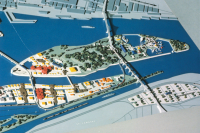Canada was an eleventh-hour stand-in for the 1967 World’s Fair and Montreal had to pull off a miracle to get it ready on time. The fair had initially been awarded to Moscow in 1960 to help celebrate the 50th anniversary of the Russian Revolution, but two years later, the Soviet Union backed out of its obligation. On 13 November 1962, Canada re-submitted its bid and won the opportunity to host in 1967. Its organizers now had only four and a half years to prepare - rather than the intended seven years. Yet Expo 67 opened its doors in Montreal on time on 28 April 1967 - four years, five months, and fifteen days later. Much of the credit for this success goes to the Director of Installations, Colonel Edward Churchill, a retired Royal Canadian Engineer officer.
The success of Expo 67 required bold vision and innovative solutions - the first of which was to create the site in the middle of the St Lawrence River based on a set of small islands and shoals and expanding Saint Helen’s Island. It would take eleven months to pile up the required twenty-eight million tonnes of stone and earth. The city of Montreal officially handed over the islands to the organizing committee in July 1964 with just two years and nine months remaining.
Everything rested on the shoulders of the Director of Installations, Colonel Churchill, who would execute the construction project and coordinate over 6,000 workers. Completing the ambitious Expo 67 project would require building some 850 pavilions and buildings, 27 bridges, 25 kilometres of roads and sidewalks, 40 kilometres of sewers, 150 kilometres of pipes, 25,000 thousand parking spots, 256 basins, and 6,150 streetlights.
Colonel Churchill was a veteran of the Second World War. He had commanded No 2 Canadian Works Section in Europe and contributed directly to the Allied success by constructing, restoring and maintaining almost 200 airfields in the United Kingdom and on the Continent. After the war, he helped build the Distant Early Warning (DEW) Line chain of radar stations across Canada’s Far North and held several senior positions in the Public Service.
Colonel Churchill took charge of scheduling the construction and implemented a modern project management technique: “The Critical Path Method.” He had very successfully pioneered this technique during the construction of the “Diefenbunker” underground federal emergency government headquarters bunker (1959-1961) at Carp, ON. The technique involved planning and distributing work in such a way that, with leading-edge computer monitoring, some 180 pavilions could be built simultaneously.
By Fall 1966, all the pavilions were virtually finished and exhibitors started setting up. Despite the scope of the project, the limited time, the technical challenges of innovative designs, and labour unrest, Expo 67 was opened on time on 28 April 1967. Few world’s fairs in modern times resonated as much within their host countries and around the world as Montreal’s Expo 67.
Colonel Churchill was awarded the Order of Canada in December 1967 for his contributions to engineering in the Canadian Armed Forces, Civil Defense Construction and as Director of Installations with Expo 1967.
Further Reading: See Maclean's Magazine Article, Jun 67, REMEMBER ALL THOSE PEOPLE WHO SAID EXPO WOULD NEVER BE READY IN TIME? NOW MEET THE MAN WHO MADE LIARS OUT OF THEM


